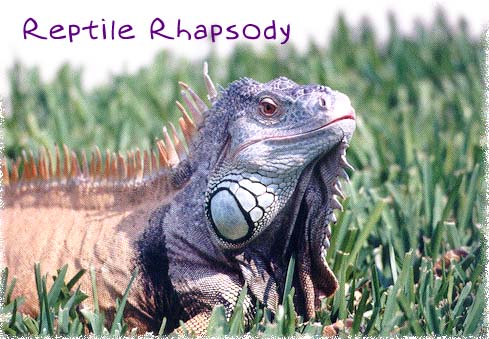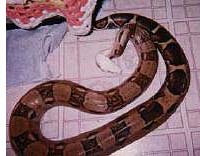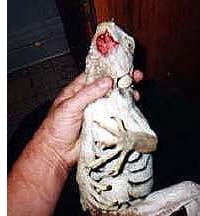

Photograph by J.Gadsby
A story of compassion for God's small creatures...
It all started simple enough, I have always loved reptiles. I grew up in Oregon chasing garter snakes and lizards in a local abandoned field near my home. So naturally, when my son expressed an interest in reptiles and asked for an Iguana, I felt like I was prepared... I was not! I was not really aware of everything involved in keeping exotic reptiles. I did just what the pet store told me to do, and, despite what I thought was the best of care, the poor Iguana died.
The lizards I grew up chasing did not need a warm cage or heat source. The pet store did not tell me that I needed to keep the Iguana warm enough to properly digest it's food, or anything about Vitamin or Calcium supplements-- or even the proper diet. They just said to keep him in an aquarium and feed him lettuce. Looking back, I am surprised he survived 2 months. The fact that he survived as long as he did is a strong testament to just how hardy these lizards can be.
There were several on-line resources available. The best of these was Melissa Kaplan's website. Because of her shared knowledge, I was able to find useful up-to-date information on the right way to keep Iguanas. I learned about Vitalights, heat lamps, hot rocks, water, diet and, most importantly, just how large a Green Iguana can grow to be! Later, by talking with other pet lovers, I found that I was not alone. Many other people kept Iguanas and, unfortunately, also had let them die without really knowing what they had done wrong. That's when I decided to write a short Iguana Care Book and give free Iguana care classes to anybody who was interested in understanding how to care for their pet.
Recently, I received a frantic call from a woman. Her Iguana was passing away from an apparent heart attack. She had kept this Iguana from the time it was a tiny baby. It was very much a part of her family, and had been for nearly 30 years. Yes, Iguana's can live to a ripe old age! We cried together as she told me how long she had owned him and what a joy he was in her home. I praised her for the type of care and dedication she had given this very lucky Iguana. We both mourned his passing.
Funny things happen when people hear that you deal with abused and abandoned reptiles. Somebody told me about a large and very aggressive Monitor Lizard, who was feared and subsequently abused by his owner. I bought the Monitor for $300.00 to get him out of his bad situation, and set about to tame him. He was firmly convinced that all people were evil, so I fitted him with a leather dog harness. I used a snake stick to take him out of the cage, by hooking it in the harness, so that I had some control over him. He only took 3 months to realize that I would not hurt him; and he settled down quickly after that. Now, 2 years later, he is the tamest and most gentle of my reptiles. He goes to schools and parties, and performs as part of a petting zoo for me. He loves all the attention now! People that knew of him before my intervention can't believe he is the same lizard. I tell them, "he did it all on his own, he just needed to know he would never be hurt by anybody else, ever again!"
Everybody is responsible for how they treat our planet, and all the living creatures on it. We must all be concerned for the ecological systems that maintain life on planet Earth-- not only for ourselves, but for future generations as well. I, for one, do not want my grandchildren to have to learn about nature from books because nothing real and living is left! Our future as a race depends on the countless plants and animals that share the world with us. We can't afford to take these things for granted or they will be gone forever.
My experiences with reptiles has shown me that even these strange looking creatures have feelings, and feel pain and suffer from neglect. I try to do my part to have compassion for each creature, no matter how big or small they may be. Hopefully, you too will think twice about God's creatures, and will keep an eye out for them. If you feel the same way as I do, I'd love to hear from you. You can contact me, Sheryl Wiesner, through Viewzone Magazine.
Sheryl Wiesner is a single parent of a teenage son. She runs a "reptile rescue" from her home, called "Reptile Rapsody". (That's how she spells it.) This is her story.  I was determined not to let another Iguana die unnecessarily in my home, so I set out to find whatever information I could to tell me what I did wrong. Instead of useful facts, I found was a vast store of conflicting information. I thought, "how could one person sort through all of this material and still have a healthy animal?
I was determined not to let another Iguana die unnecessarily in my home, so I set out to find whatever information I could to tell me what I did wrong. Instead of useful facts, I found was a vast store of conflicting information. I thought, "how could one person sort through all of this material and still have a healthy animal? Before long, I started receiving calls from people who had either found an Iguana, or had to give up their Iguana, for whatever reason. This started the rescue project. We call ourselves, "The Home of the White Iguana" because most of the rescues, at that time, were Iguanas over 3 ft in length! It is surprising how many people purchase an Iguana as a pet without realizing just how big it gets, or think that they can just "give it to a zoo" when it is too big for them to handle. Now, I receive calls from all over America. I get calls from the Animal Control, Pet Stores, Animal Rehabbers and private people, who have had to give up their reptiles. Since I started tracking the rescues (almost 2 years ago), I have received about 190 abandoned, sick or injured reptiles! Most of them have gone on to new homes; but a few don't survive because they are either too sick or injured by the time they finally get to me.
Before long, I started receiving calls from people who had either found an Iguana, or had to give up their Iguana, for whatever reason. This started the rescue project. We call ourselves, "The Home of the White Iguana" because most of the rescues, at that time, were Iguanas over 3 ft in length! It is surprising how many people purchase an Iguana as a pet without realizing just how big it gets, or think that they can just "give it to a zoo" when it is too big for them to handle. Now, I receive calls from all over America. I get calls from the Animal Control, Pet Stores, Animal Rehabbers and private people, who have had to give up their reptiles. Since I started tracking the rescues (almost 2 years ago), I have received about 190 abandoned, sick or injured reptiles! Most of them have gone on to new homes; but a few don't survive because they are either too sick or injured by the time they finally get to me.  I have received reptiles that were in such poor health that they would make any humane person cry. Others were healthy but aggressive that they were actually dangerous in the wrong hands. I carefully screen prospective homes for my rescued friends, as I am a bit of a "mommy" when it comes to my "babies".
I have received reptiles that were in such poor health that they would make any humane person cry. Others were healthy but aggressive that they were actually dangerous in the wrong hands. I carefully screen prospective homes for my rescued friends, as I am a bit of a "mommy" when it comes to my "babies". Every day there is a different story, and each reptile that comes to me has it's own tale to tell. One time, while I was at work, a friend of a co-worker came to me, frantic and fearful. It seems that her boyfriend had a "very large snake." This snake had escaped its cage and she was afraid that it would kill and eat her Boxer. My boss graciously allowed me to leave work to see what I could do to "round up" this wayward snake. When we got to her house, she showed me the snake's cage-- a 30 gallon aquarium with a screen lid taped to the top. Surely, I thought, this snake could not be as big as she had described and still live in this cage. She then took me out to the back yard and showed me where she had last seen the snake. I looked everywhere and found no sign of him, until I looked up. I don't know how I could have missed him. There he was, all 3 and a half feet of him, dangling from a small tree! This poor little snake, I'm sure, had no idea of all the panic and commotion it had caused! Here I was looking for a huge Python that was a danger to a large dog, and it was only a "little guy" who was not much bigger around that a thick rope! I took the poor little snake home and found him a loving family where he still lives happily. He is now 7 feet and weighs 20 lbs.
Every day there is a different story, and each reptile that comes to me has it's own tale to tell. One time, while I was at work, a friend of a co-worker came to me, frantic and fearful. It seems that her boyfriend had a "very large snake." This snake had escaped its cage and she was afraid that it would kill and eat her Boxer. My boss graciously allowed me to leave work to see what I could do to "round up" this wayward snake. When we got to her house, she showed me the snake's cage-- a 30 gallon aquarium with a screen lid taped to the top. Surely, I thought, this snake could not be as big as she had described and still live in this cage. She then took me out to the back yard and showed me where she had last seen the snake. I looked everywhere and found no sign of him, until I looked up. I don't know how I could have missed him. There he was, all 3 and a half feet of him, dangling from a small tree! This poor little snake, I'm sure, had no idea of all the panic and commotion it had caused! Here I was looking for a huge Python that was a danger to a large dog, and it was only a "little guy" who was not much bigger around that a thick rope! I took the poor little snake home and found him a loving family where he still lives happily. He is now 7 feet and weighs 20 lbs. Another time, I stopped at a local animal control. Someone had told me that they had this "huge vicious snake" there and that they needed to find a home for it. Here was this poor 9 foot long, Burmese Python, in a metal dog cage, in an unheated brick building, in the middle of December! Some of the workers were compassionate enough to have given him a blanket. They had even placed hot water bottles inside his cage during the night, so he would not get too cold. He had a large sign on his cage that read, "Caution! Dangerous Snake!." When I went up to the cage he came right up to me. When I placed my fingers into the cage he rested his head on my hand! It was obvious that he was sick from the cold, as he had mouth rot and mucous bubbling from his nose. I bought him with the help of a volunteer who talked the manager into letting me have the snake for $45.00 (He wanted $100.00). This poor boy went straight to the Vet where he was started on antibiotics and supportive fluids He recovered nicely and went to a new home a couple of months later.
Another time, I stopped at a local animal control. Someone had told me that they had this "huge vicious snake" there and that they needed to find a home for it. Here was this poor 9 foot long, Burmese Python, in a metal dog cage, in an unheated brick building, in the middle of December! Some of the workers were compassionate enough to have given him a blanket. They had even placed hot water bottles inside his cage during the night, so he would not get too cold. He had a large sign on his cage that read, "Caution! Dangerous Snake!." When I went up to the cage he came right up to me. When I placed my fingers into the cage he rested his head on my hand! It was obvious that he was sick from the cold, as he had mouth rot and mucous bubbling from his nose. I bought him with the help of a volunteer who talked the manager into letting me have the snake for $45.00 (He wanted $100.00). This poor boy went straight to the Vet where he was started on antibiotics and supportive fluids He recovered nicely and went to a new home a couple of months later. Some stories are not so happy. I have received school pets in such bad shape that they died in a couple of days. It saddens me to think that an educator would not know or care enough about the animals in the classroom, or to learn how to properly care for them. One such school "pet" was an Iguana that I have named "Selea." Selea came in with her cage mate from a local school. The teacher said the school budget would not pay for veterinary care and, since Iguanas were cheap, he would just buy 2 more for the classroom! The first Iguana died in transit to my home! The other one (Selea) required antibiotics to treat an infection that caused numerous blisters on her skin. She also required surgery to repair a burned shoulder. The ulceration had gone clear to the bone!
Some stories are not so happy. I have received school pets in such bad shape that they died in a couple of days. It saddens me to think that an educator would not know or care enough about the animals in the classroom, or to learn how to properly care for them. One such school "pet" was an Iguana that I have named "Selea." Selea came in with her cage mate from a local school. The teacher said the school budget would not pay for veterinary care and, since Iguanas were cheap, he would just buy 2 more for the classroom! The first Iguana died in transit to my home! The other one (Selea) required antibiotics to treat an infection that caused numerous blisters on her skin. She also required surgery to repair a burned shoulder. The ulceration had gone clear to the bone!  Selea also accompanies me on the educational shows and has even done her own music video! I am grateful to the caring educators, who keep healthy reptiles in their classrooms, as these educators give an example of how to be responsible for all life trusted to our care.
Selea also accompanies me on the educational shows and has even done her own music video! I am grateful to the caring educators, who keep healthy reptiles in their classrooms, as these educators give an example of how to be responsible for all life trusted to our care.